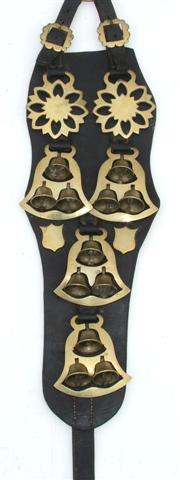Bell Brasses
R.J. Bradshaw.
There can be little doubt regarding the popularity of bell-brasses with collectors over the years. Most types command a steady price and as was stated in the NHBS publication, Collecting Horse Brasses Vol 1, "In the 19th Century bell brasses were two or three times more expensive than ordinary brasses. In consequence today none can be said to be common and most can only be described as rare". (p27)
The NHBS publication, Horse Bells (1988) covers the history of this subject in even more detail beginning with the earlier and much rarer types such as rumbler bells and latten bells. Here however, we will look at those more commonly associated with the decorated heavy horse from the late 19th-early- 20th century. Those that a collector is most likely to come across today, are bell-terrets, bell rosettes and bell face-pieces.
Below, an impressive four-horse team displaying belfries containing open-mouthed latten bells typical of the early 19th C. This photograph came from Kent, and dates from c.early 1900's and seems to be celebrating an earlier era perhaps? A detailed history of these early bells can be found in the NHBS publication, Horse Bells.
From the various pattern books published during the late 19th Century, we are able to find a few bell-facepieces, and a good selection of terrets and bell-rosettes. The firm of William Thacker of Walsall (1905) provide a page of similar ornaments as those illustrated below, but by far the most impressive is, once again, to be found on page 50 of Hampson and Scott's Equine Album, mainly because of its use of early colour printing techniques.
 On page 44, of the same catalogue (see stamped brasses section) there can be seen a bell-facepiece manufactured by the stamping process, which is reckoned to be the only such to have been made thus. Why other, more simple patterns were not produced by this process is something of a mystery as almost without exception, bell-facepieces were made by the casting method.
On page 44, of the same catalogue (see stamped brasses section) there can be seen a bell-facepiece manufactured by the stamping process, which is reckoned to be the only such to have been made thus. Why other, more simple patterns were not produced by this process is something of a mystery as almost without exception, bell-facepieces were made by the casting method.
Recently however, another such item came to light which does seem to be made from the die-struck process (at least in part) which is the single-bell face-piece illustrated first left, below. The main frame of the brass has been cut from 2mm sheet brass in a single blow, leaving tell-tale burring around certain parts of the outer edge. The lugs to contain the pin on which the bell swings are small pieces of cast brass sweated in with what looks like a high-temperature gas braze, with the bell being added, as always, during the final stages of assembly.
Below, a very rare, and so-far unrecorded, bell-facepiece, (far left) which has a stamped frame. Next to it a rare cast, Lyre shaped frame followed by two very desirable bell crescents. The NHBS publication, Horse Bells states that, "Some twenty five designs of bell face pieces are known from the 19th and early 20th centuries. Of the twenty five, twelve have bell shaped frames, the others are circular or other well known shapes." (p31)
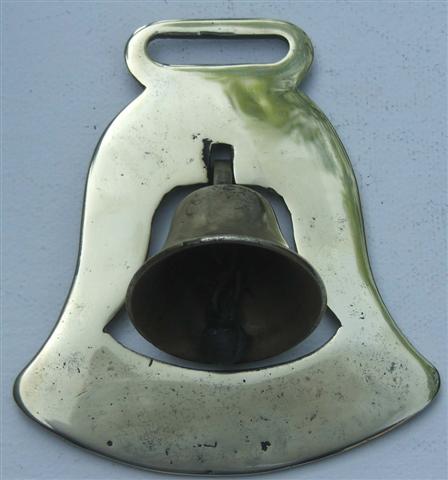
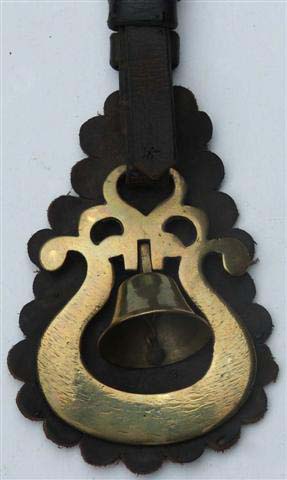
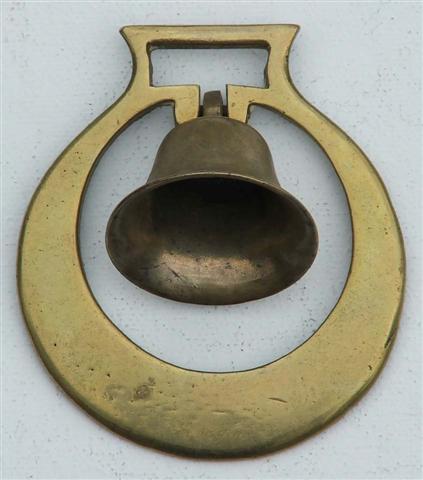
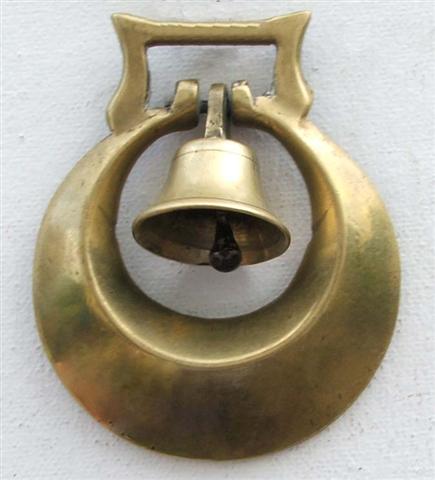
Below, other examples of cast bell-facepieces. As already stated, there are some twenty five (now 26) known types, though the bell in the bell shaped frame is perhaps the most numerous example that will be found. Certain varieties of this type do surface from time to time, and some have a different bells mounted in them for instance, which is probably due to the fact that manufacturers used what materials were to hand on any given day. The brass in the middle for instance has its getts left intact, probably to allow the bell to swing more freely?
Three more types below; the one on the far left does not appear in any reference material on the subject either. Certain Two-bell versions in a similar frame are known, but this one seems to have gone unrecorded making our total now at 27. The central stars-in-ring type is also a strange piece being perhaps the only bell-facepiece to have the bell mounted on a large projecting stud, which was burred over when the bell was fitted. This leaves very little room for the bell to swing back and forth, but strangely enough, it would still tinkle quite well were it swinging on a harness loop. The brass on the far right is a well-known brass which came from the factory of William Overton in Walsall.
Below, a nice turnout here (though completely unknown), which won him 3rd Prize. Note the two triple-bell brasses mounted side-by-side on the bottom of the Martingale.
Below, two three-bell types. The left hand brass (if the catalogue illustration is anything to go by) may have been from the factory of Hampson & Scott, but the right hand brass is another well-known Overton brass, and is hard to come-by.
Below, a pair of splendid martingales containing rare three-bell types, that we find every night in our dreams, and a very nice example of a stamped bell martingale. Whatever horse brasses collectors favour most, there is no doubt that bell-types quite often occupy a special place in most "wanted" lists, so good hunting, and please dont forget to let us know if you find an unrecorded type!!!

